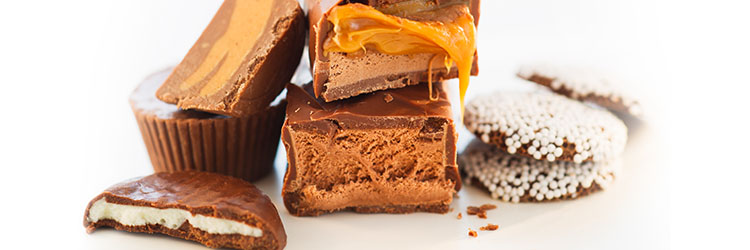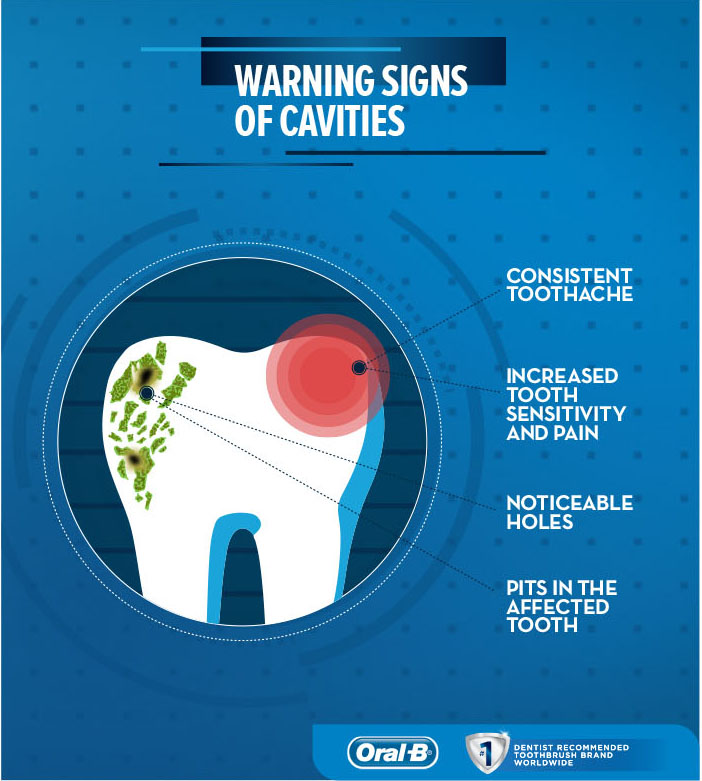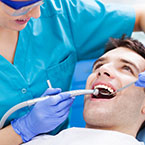TOOTH DECAY AND CAVITIES: SYMPTOMS, CAUSES AND TREATMENT

- What Is a Cavity?
- What Causes Cavities and Tooth Decay?
- Signs and Symptoms of Tooth Decay and Cavities
- Cavity and Tooth Decay Treatment
- How to Prevent Cavities and Tooth Decay
- Questions Related to Cavities and Tooth Decay
Tooth decay is the softening of your tooth enamel caused by acids. These acids are created when plaque bacteria break down sugar in your mouth.
What Is a Cavity?
It’s actually pretty simple. Decay (or softening of enamel) happens over time and, when tooth decay is not properly addressed, the result is a cavity—a defect left in the tooth. Teeth are covered with a hard, protective outer layer called enamel. But once the enamel is weakened by acids produced by bacteria in your mouth, a pit or cavity can form in the tooth surface.
What Causes Cavities and Tooth Decay?
Tooth decay (such as a cavity) can occur for several reasons, one of which is when foods containing carbohydrates become trapped between teeth and are not completely removed with brushing and flossing. The plaque bacteria generate acidic by-products that eat away at the tooth’s enamel, slowly creating holes in the teeth called cavities. Without treatment, these holes can grow larger over time and may even destroy the whole tooth.
Some of the major causes of tooth decay are sugary, sticky foods and beverages. The more sugar consumed, the more acid leading to decay gets produced by the bacteria in your mouth. Sugar combined with plaque weakens the enamel leaving you vulnerable to tooth decay. Each time you eat a sugary snack, your teeth are vulnerable to damage from the acids produced by the bacteria. It is important to understand the causes of tooth decay so you can learn the proper way to care for your teeth and care for your health.
Common Causes of Tooth Decay and Cavities
- Specific foods and drinks. Foods that cling to your teeth are the most likely to promote tooth decay. All sugars and most cooked starchy foods are major plaque promoters, including milk, honey, raisins, hard candy, dry cereal, and bread.
- Frequent snacking. Some diets suggest eating several small meals each day to help lose weight or maintain weight loss. But remember that if you snack frequently, no matter what type of food, the acid produced by the bacteria has more time to damage your teeth. Consider brushing your teeth with a fluoride toothpaste after eating to remove plaque.
- Receding gums. If your gums are receding, plaque can form near the roots of the teeth, which are not protected by tooth enamel and are more vulnerable to decay.
Signs and Symptoms of Tooth Decay and Cavities
The most common and effective treatment for tooth decay and cavities is a filling, which stops the cavity from growing any larger. So, if you are experiencing any signs of tooth decay or a cavity, it is extremely important to see a dental professional immediately for treatment.
The use of products containing fluoride, such as fluoride toothpastes and an anticavity rinse, can help prevent tooth decay and cavities. Fluoride flows into weak spots to help rebuild these areas before they can become cavities.

Cavity and Tooth Decay Treatment
The most immediate form of treatment is to see your dental professional to have the cavity filled.
If you have dental fillings, it’s important to check your fillings for signs of wear and tear as part of your daily oral health routine. Over time, the edges of dental fillings can become rough, and the filling material can weaken and begin to break down. Rough or weak fillings may make plaque removal more difficult because plaque can build up in those areas.
When Fillings are Needed
If you develop tooth decay that has progressed beyond the process of eroding your tooth enamel and has created holes in your teeth, your dentist will likely recommend a filling. When you get a filling, your dentist will remove the decayed material from the tooth and replace it with something else to restore the shape of the tooth. Fillings can be made of tooth-colored resins, amalgam, or ceramic materials.
When Crowns are Needed
If your tooth decay is severe, your dentist will likely use a crown rather than a filling to repair the damage. A crown is larger than a filling and covers the top of the tooth once the decayed area is removed and filled. Crowns are usually made from porcelain, gold, or ceramic materials.
No matter what type of filling or crown you have, be sure to follow a complete oral care routine of brushing your teeth twice a day (especially with fluoride toothpaste) and daily flossing to remove plaque and prevent future tooth decay. There are lots of products designed to help you clean around dental work such as fillings and crowns. Your fillings and crowns should not need to be replaced unless they have recurrent decay, show signs of wear or become loose or defective in some way.
How to Prevent Cavities and Tooth Decay
To help prevent tooth decay and cavities certain measures can be taken to help strengthen your teeth:
- Eat Healthy: Follow a healthy diet and avoid sugary foods and drinks that feed the decay-causing bacteria in your mouth.
- Fluoride Toothpaste: Brush regularly with fluoridated toothpaste. One of the best ways to prevent mineral loss from the tooth or demineralization and help the replacement process or remineralization is by using toothpaste that contains stannous fluoride, like Crest Pro-Health Densify Toothpaste. Stannous fluoride helps prevent cavities by slowing the breakdown of enamel and speeding up the remineralization process. The new enamel that will form is harder and more resistant to acid. Many scientific studies over a long period of time have proven this to be one of the most effective ways to prevent tooth decay.
- Daily Flossing: Floss daily with Oral-B Glide Pro-Health Deep Clean Mint Floss to help remove plaque and food particles from the spaces between your teeth where a toothbrush can’t reach. This helps promote healthy teeth as well as healthy gums. Pair standard string floss with the Oral-B Water Flosser, its unique Oxyjet Technology helps to target and eliminate plaque buildup for healthier gums*.
- Regular Checkups: Schedule regular visits with your dental professional, approximately every six months, for a routine cleaning and exam.
- Change Your Toothbrush: Remember to change your toothbrush when it looks worn, or every three months, because the newer the bristles, the more plaque the brush is able to remove. Switch to an electric toothbrush to easily swap out brush heads every 90 days. Plus, an electric toothbrush like the Oral-B iO9 helps to remove more plaque than a regular manual toothbrush while delivering a professional clean feeling every day.
- Sealants: The deep grooves and pits in some teeth, such as molars, can also be trouble spots for decay. One way to prevent this type of decay is to have your dental team paint a shaded resin material called a pit and fissure sealant on these areas. Once the sealant hardens, it acts as a barrier protecting the tooth’s surface from plaque and acids.
- Fluoride Supplements: Fluorides also play a significant role in preventing decay. By adding fluoride to your water or including a fluoride rinse in your daily oral routine, you can help to better protect your teeth from cavities and bacteria. Fluoride supplements are also available and can help keep your mouth clean and healthy.
*Helps reduce plaque bacteria and inflammatory components associated with gingivitis, when used as an adjunct to brushing, flossing and regular professional care.
Questions Related to Cavities and Tooth Decay
Aren’t Cavities Just an Issue for Kids?
Children are very prone to cavities, often on the chewing surfaces where food gets trapped in crevices that kids are likely to miss while brushing. But adults get cavities as well, primarily on the tooth surfaces between their teeth. If teeth are spaced tightly, it’s hard to clean between them to remove plaque. People who experience gum recession may also develop cavities on exposed root surfaces.
How Often Should My Teeth Be Checked for Cavities?
You should plan on seeing your dental professional twice a year for checkups. While checkups can vary, your dental professional will most likely examine your teeth and gums for any visible problems, including any signs of tooth decay, infection, and gum disease.






